Have you walked past someone on the sidewalk or waited at a counter next to someone who looked vaguely familiar? Something about her smile, about his gesture draws your attention, suggested that this was someone you should know. And, you may be right. You may be reacting to a certain poise and confidence, an indefinable quality of character.
Some notable, even famous people call Annapolis and the Eastern Shore “home.” You may know him as the guy who walks the handsome dog, or she’s the woman with the infectious smile, but in their worlds—the worlds of art, literature, music, and scholarship, they are stars, even supernovas.
Let me introduce you to just a few of our brilliant and famous, neighbors: Dr. Eva Brann, archeologist, translator, philosopher, author, pedagogue; Grace Cavalieri, poet, playwright, radio host; Brian Ganz, concert pianist, essayist, pedagogue; Leonard Koscianski, contemporary artist; Ulrika Leander, fiber & tapestry artist.
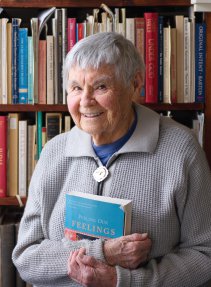
Eva Brann Ph.D
You may have seen a grandmotherly lady making her way across St. John’s campus or enjoying dinner with a student at a local eatery. Behind those sparkling eyes resides a brilliant and intrepid thinker. Dr. Brann is the author of 14 books on wide-ranging philosophical topics and translator of five works by Plato and a modern study of mathematics.
"When he wanted to be feeling his feelings, was there a difference between the general feeling, the mere consciousness of being affected, and his particular feelings, the distinguishable affects?”
Over more than 60 years as a member of the faculty at St. John’s, Eva Brann has been dean and tutor to perhaps a thousand students. Her students inspire her writing and her adventures. In one interview, Dr. Brann reflected on the inspiration for her book, Feeling Our Feelings: What Philosophers Think and People Know:
“Feeling our Feelings comes from the words a little boy called Zeke said to me some 30 ago when he was four. I was swinging him in a park in Cambridge, Massachusetts, and not doing it right. ‘Swing me higher,’ he says, ‘I want to feel my feelings.’ The phrase stuck with me; you might say it festered in my mind; …When he wanted to be feeling his feelings, was there a difference between the general feeling, the mere consciousness of being affected, and his particular feelings, the distinguishable affects?—as, when you sing a song, there is a difference between the singing done and the song sung—or is there?”
Nothing escapes her attention and keen intellect, not even the observations of a toddler.
Eva Brann keeps up a lively correspondence with former Johnnies, exchanging letters (yes, the old-fashioned way), and visits to a cattle ranch in Montana and sailing in New Zealand. Should you have the good fortune to make the acquaintance of Dr. Brann, relax and enjoy the ride; you may find yourself discussing the force of education in a republic or the best place in Annapolis to buy cookies.
But wait, one more thing: As a recipient of the National Humanities Award, Dr. Eva Brann’s work, according to the National Endowment for the Humanities, “has deepened the nation’s understanding of the humanities and broadened our citizens’ engagement with history, literature, languages, philosophy, and other humanities subjects.”
__________________________________________________________________
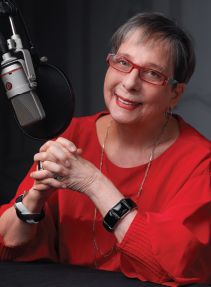
Grace Cavalieri
If you’ve been lucky, after a swim at the county pool or an hour at a Buddhist meditation session, you may have encountered a petite, spritely woman who radiated joie de vivre and made you feel as though you were the most interesting person around. Before your encounter was over, she understood your dreams, laughed at your jokes, and persuaded you to read the works of two new poets. Well, that’s poet, playwright, and radio talk-show host, Cavalieri.
"The minute I was born, I wanted it [communication]. I was able to jump on any opportunity I saw to communicate. The stage extended itself to me...radio extended itself.”
Cavalieri is renowned for her 40-plus years of radio interviews with American poets, both famous and yet-to-be. During her program, The Poet and the Poem, Grace Cavalieri explores the work of her guests and encourages them to read a few of their poems aloud. Cavalieri’s deeply personal understanding of the art and craft of writing turns her interviews into thoughtful and sometimes amusingly intimate conversations, like she did with Billy Collins and Louise Gluck.
She has interviewed every U.S. Poet Laureate and some of the “Poetry Consultants,” a recognition that preceded U.S. Poet Laureate. Recently, she interviewed Tracy K. Smith, current U.S. Poet Laureate. Poet and friend, Hiram Larew, says of Cavalieri, “Grace has just been such a poetic force in the D.C. area…. She is recognized for her contributions to poetry in America.”
The Poet and the Poem is recorded for Public Radio at the Library of Congress and is available as podcasts and on iTunes (loc.gov/poetry/media/poetpoem.html).
And what does she do in her spare time? Well, Cavalieri has written 26 plays and 20 collections of poetry, and, if that doesn’t take your breath away, she writes a monthly poetry review for The Washington Independent Review of Books. Last fall, her newest volume of her poems, interviews, and play excerpts was released, Other Voices, Other Lives: A Grace Cavalieri Collection (gracecavalieri.com).
Acknowledged as one of the leading figures in contemporary American poetry, Grace Cavalieri has been honored with numerous awards. Among them are the Pen-Fiction Award, the Allen Ginsberg Poetry Award, The Corporation for Public Broadcasting Silver Medal, the American Association of University Women, and the inaugural Columbia Merit Award for “significant contributions to poetry.”
Theater also plays a vital role in Cavalieri’s creative life. In an article in Scene4 Magazine, Kathi Wolfe quotes Cavalieri:
“The minute I was born, I wanted it [communication]. I was able to jump on any opportunity I saw to communicate. The stage extended itself to me… radio extended itself.”
Her play Quilting the Sun goes into production in New York City in 2019.
Artistic achievements and recognition aside, Cavalieri identifies her greatest achievements as her marriage of nearly 60 years and her four daughters, their children, and a new great-grandson. Her husband, Kenneth Flynn, a naval officer and sculptor, died in 2013.
________________________________________________________________
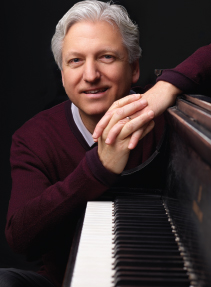
Brian Ganz
If you listen to classical radio on the way to work, every once in a while, a particular composition or artist’s performance may capture your attention as the cars inch along the beltway. Remember that exquisite Chopin etude you heard performed with such passion and grace? Who was that playing that Steinway? It may have been Brian Ganz, classical pianist and member of the faculty at both St. Mary’s College of Maryland and the Peabody Institute. You may have attended one or more of his charity performances in and around Annapolis, given to support such charitable organizations in our community as the Lighthouse Shelter and the All Children’s Chorus of Annapolis.
"I was struggling, unsure of my abilities as a pianist. My teacher persuaded me to put myself on the line, get out there and find out what I could do.”
Noted for his brilliant performances of the compositions of Polish composer Frederic Chopin, Ganz explains, “[Chopin] feels to me like the native language of my soul…His language, the way he writes a melody—his harmony—in unexpected ways, sounds inevitable.” And, if you’ve attended one of Mr. Ganz’s performances you know the magnetic energy and passion he brings to the music. The audiences remain spellbound while Mr. Ganz weaves his web of beautiful music.
Ganz has performed with world famous conductors and their orchestras, including Leonard Slatkin, Marin Alsop, Mstislav Rostropovich and Piotr Gajewski, as well as The City of London Sinfonia, the St. Petersburg Philharmonic, and the Baltimore Symphony Orchestra.
This year has been incredibly busy for Ganz. In the spring, he performed at the Alba Music Festival in Alba, Italy. Then, to honor the 100th anniversary of Poland’s independence, Mr. Ganz performed Chopin’s Piano Concerto No. 2 with the National Philharmonic at Strathmore. That performance was part of a project begun in 2011; Mr. Ganz and the National Philharmonic Orchestra are performing all the works of Frederic Chopin. In late summer, he again performed Chopin’s Piano Concerto No. 2 at the River Concert Series at St. Mary’s College of Maryland.
Reflecting on his life’s journey from student musician to internationally renowned concert pianist, Brian Ganz recalls his artistic turning point almost 30 years ago: “I was struggling, unsure of my abilities as a pianist. My teacher persuaded me to put myself on the line, get out there and find out what I could do.” Young Ganz headed for Paris, and there his performances earned a laureate in the Marguerite Long Jacques Thibaud Piano Competition. “That was a significant spiritual ‘sign from God,’ a nod from the universe,” stated Ganz.
In his teaching, both at Peabody and at St. Mary’s, Ganz provides the same encouragement and support, helping each student find their own nod or sign. Brian Ganz continues to seek his own signs in the heady world of international concert performances. (brianganz.net)
_______________________________________________________________
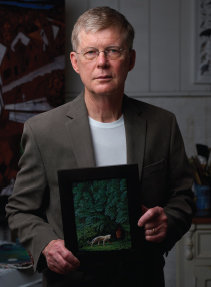
Leonard Koscianski
Perhaps you’ve seen an intense redhead jogging up Main Street before dawn. Or, if you’ve wandered through the art exhibited at an Art Between the Creeks show, you may have stopped short to ponder the startling oil painting with the NFS tag—the work of internationally acclaimed artist, Koscianski.
"My paintings are narrative. Perhaps the animals are our natural, biological, visceral selves; while the houses in the backgrounds are the civilization I find myself a part of…
brI believe ours is a fractured culture, which while providing an entrapping safety and security for some also generates intense anger and hostility.”
Koscianski made his way to Annapolis from his childhood home in Ohio, via California and Manhattan. Recognized early for his works’ originality and power, Koscianski’s paintings are in the collections of the Metropolitan Museum of Art, the Chicago Art Institute, and the Philadelphia Museum of Art, to name a few. The Meisel Gallery in New York City, the Berman Gallery in Los Angeles, the J. Willott Gallery in Palm Springs, and the Carl Hammer Gallery in Chicago represent him.
Among the acknowledgements of Koscianski’s exceptional talent are the Individual Artist Fellowship from the National Endowment for the Arts, and the Rockefeller Foundation’s Bellagio Fellowship.
Encouraging Art in our community is vital to Koscianski. He served on the Annapolis Art in Public Places Commission, and he is a founding member of Art Between the Creeks, an artists’ cooperative.
Of his own works, Koscianski says: “On some level, it [my painting] is simultaneously a panorama and a self-portrait. My paintings are narrative. Perhaps the animals are our natural, biological, visceral selves; while the houses in the backgrounds are the civilization I find myself a part of…I believe ours is a fractured culture, which while providing an entrapping safety and security for some also generates intense anger and hostility.”
His paintings are in oil, usually on large canvases, and he often works in series. Perhaps you’ve seen his orchids series or the leaping fish, or recently, Koscianski has used his morning runs through Annapolis’ sleeping neighborhoods as inspiration. This latest series pays homage to small town America, or Annapolis if you like; the church with its spire and stained glass, the manicured lawns where dogs sprawl or crouch, the lighted windows revealing families going about their daily lives. In this series, there is a skewed perspective, slight distortions that may be foreboding or amusing. Time, too, seems to lose its way—with daylight and nighttime sharing the same scene.
Enjoy a private tour of Leonard Koscianski’s work on his web site, or stop by the Meisel Gallery when next you’re in New York City. (leonardkoscianski.com)
______________________________________________________________
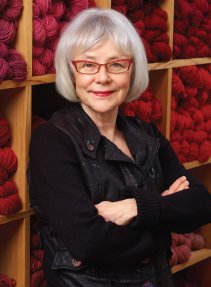
Ulkrika Leander
Perhaps you’ve enjoyed a sunny day bicycling or driving between St. Michaels and Oxford. As you pedaled through the farmland and woods, toward the Oxford-Bellevue Ferry, you passed a tidy building that once housed a general store. Now, its home to two magnificent looms plied by a visionary, contemporary tapestry artist, Leander.
"I believe that I am drawn to tapestry weaving by the endless fascination of watching the gradual unfolding of the chrysalis that is my design, into a tapestry that will uplift the spirit and bring new life to an architectural space in a way that fulfills my client’s expectations for a work of enduring beauty and worth.”
Leander weaves tapestries, usually of breathtaking size and sumptuous colors, which hang in corporate headquarters, courthouses, and churches, as well as museums and private homes around the world. Working in glowing colors of luxurious wool, Leander creates tapestry art that reflects both her childhood in Sweden and her adulthood in the U.S. She explains:
“The rich history and tradition of textile art and design became part of my consciousness at a very early stage of my life and the Scandinavian design aesthetic is a strong influence to this day…I believe that I am drawn to tapestry weaving by the endless fascination of watching the gradual unfolding of the chrysalis that is my design, into a tapestry that will uplift the spirit and bring new life to an architectural space in a way that fulfills my client’s expectations for a work of enduring beauty and worth.”
Over the altar of a Catholic church in Little Rock, Arkansas, hangs a 14-foot tall by 7-foot wide Leander tapestry, “Evensong.” Its liquid blues, mauve, and gold swell and flow through the abstract design, which suggests music or grand cloud formations. On the walls of a Boston law firm are two tapestries: One, 6 feet by 14 feet, “Downtown,” depicts in vivid colors Boston’s buildings and parks. The second tapestry, “Seven Fifteen,” is 4 feet by 11.5 feet and depicts the monochromatic morning rush hour. In the United States District Court of the District of Columbia, Washington, D.C., hangs Leander’s monumental “William B. Bryant Tapestry,” commissioned by the Court soon after Judge Bryant died. The 6.5-foot by 14-foot tapestry is a prismatic depiction in glorious colors of the life of the first African-American Chief Judge of the U.S. District Court for the District of Columbia.
From her original watercolor painting to the finished tapestry, Leander creates art in media that is both antique and modern, art that transforms spaces, provoking thought and bringing richness and light (ctw-tapestry.com/index.html).
Artists, musicians, scientists, inventors, and so many other creative people enrich our community. Say hello to the fellow sipping his coffee at the next table; share your newspaper with the woman enjoying the view from a bench at the city dock. Perhaps you can strike up a conversation and learn she’s an astrophysicist or that he’s just joined the Ballet Theatre of Maryland.